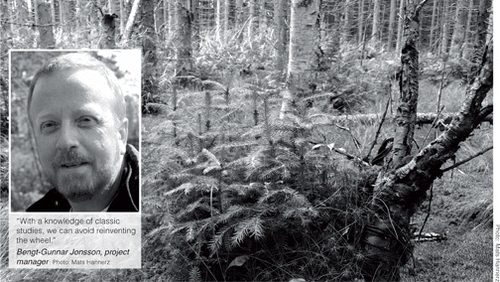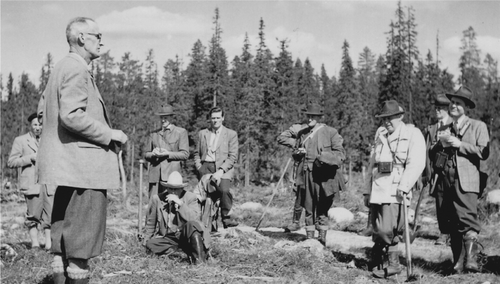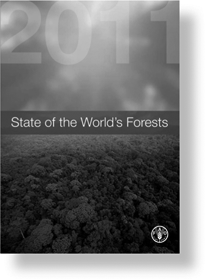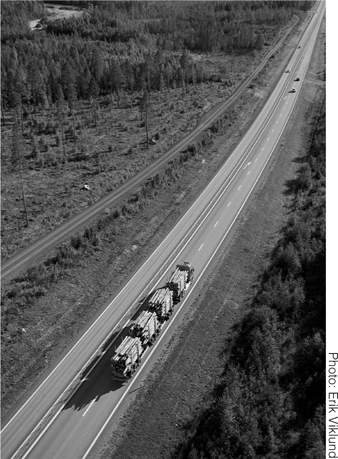PRIFOR takes on the pioneer's work
 Today's scientists can learn a lot from historical investigations. Many significant studies in forest ecology were conducted in the early to mid 20th century, but they tend to be neglected in the current flush of new scientific articles.
Today's scientists can learn a lot from historical investigations. Many significant studies in forest ecology were conducted in the early to mid 20th century, but they tend to be neglected in the current flush of new scientific articles.
The SNS-supported network PRIFOR took on the challenge of reintroducing some classic ecological investigations to the scientists of today. The result was a special issue of Scandinavian Journal of Forest Research (Supplement 10, 2011), in which ten important studies were described and analysed.
“We identified a need to present these studies to an international audience, since many of the early scientists only published their works in their national language”, says Professor Bengt Gunnar Jonsson, who is coordinating the network, the full name of which is the Nordic Working Group on the Ecology of Primeval Boreal Forests.
PRIFOR focuses on the ecology, natural dynamics and history of the remaining primeval forest of northern and central Europe. It is, therefore, natural for the network to look at the studies undertaken in the early twentieth century, when natural and near-natural forests were still abundant. At that time, researchers were aware of the pristine nature of their study areas, but for most this was not of major interest. Instead, the motivation of the researchers was to gather information on natural forest structures and developmental patterns that could assist in formulating silvicultural prescriptions and utilising the forest more efficiently.
Today, their work can be appreciated from the opposite perspective. The studies give an insight into natural conditions in forest ecosystems, helping to guide forest management towards valuing biodiversity.
Same data, different questions
“One important lesson is that the dominant contemporary questions have a strong influence on what is considered interesting, even with the same basic empirical data at hand”, says Bengt Gunnar Jonsson.
One example of the classic studies is by Gustaf Sirén, on old Norway spruce, and was published in 1955. His investigation had a strong impact on the introduction of clear-cutting systems, but today it represents a comprehensive model of the long-term development and stability of natural moss–conifer boreal forest. Some of his conclusions, e.g. that productivity declines with each tree generation, have however been questioned by today's researchers.
Studies of natural forest ecosystems had practically ceased to be undertaken by about 1940, when the focus of forest research shifted to questions of modern efficient forestry, including methods of cutting and thinning, soil preparation, planting and tree breeding. It was not until the 1990s that the study of natural ecosystems was revived within forest research.
Final truths
In the absence of continued studies of natural and near-natural systems, the results and interpretations presented in the pioneer studies became generalized as “final truths”, and even “myths”. Today, some of the early investigation's conclusions have been questioned, but many have also become widely accepted.
Bengt Gunnar Jonsson hopes that the old classic studies will gain respect in the modern scientific community. The study designs were not always the best from a statistical viewpoint, but this was compensated for by extensive data and field observations, which are seldom collected today.
“With a knowledge of these classical studies, we can avoid repeatedly reinventing the wheel”, he says.
About PRIFOR
The Nordic Working Group on the Ecology of Primeval Boreal Forests (PRIFOR) was formed in 2006 and has continued as a loose network between researchers and PhD students in northern Europe and the mountainous regions of central Europe. Their common interest is the study of the remaining primeval conifer dominated forests. A set of goals has been identified:
| • | Review the status of primeval forests in northern Europe | ||||
| • | Identify knowledge gaps (including the reanalysis of old classic works, as described here) | ||||
| • | Develop standard sampling protocols | ||||
| • | Establish a database of long-term permanent plots | ||||
| • | Arrange PhD courses | ||||
| • | Devise forest management recommendations, e.g. for forest restoration. | ||||
The network arranges and coorganises 2 or 3 meetings each year.
In 2012, the network has linked its activities to another SNS/EFI network: Natural disturbance dynamics analysis for forest ecosystem management.
Webpage: www.miun.se/nat/prifor
Contact: Professor Bengt Gunnar Jonsson, Mid Sweden University, Sundsvall. [email protected]
Professor Lars Tirén was one of the pioneers reintroduced by the PRIFOR network. Here Tirén (to the left) teaches reforestation in the field. Photo: SLU, Forestry Library.

Examples of classic Studies
Sernander's gap dynamics theory
In 1936, Professor Rutger Sernander presented the very first formulation of a general theory of forest dynamics driven by storm felling in fire refugia. The studies were conducted in two forests in central Sweden, and the theory is now almost fully accepted, although some aspects are still debated.
Vainio's studies of vegetation relationships
Edvard August Vainio defended his doctoral thesis on relationships between plant species in the border region of NE Finland and Russian Karelia in 1878. He identified vegetation patterns and how they correlated with chemical, physical and other conditions. Vainio was the first researcher to express ideas of site-type classification based on vegetation patterns.
Malmström's forest history of Halland
In 1939, Carl Malmström published the first paper based on his extensive studies of 300 years of forest history in the province of Halland, southern Sweden. His historical forest maps show the decline of the broadleaved forests in southern Scandinavia, and that the changes were due to land-use patterns. The temporal changes in vegetation cover and his notes about likely anthropogenic drivers are applicable to a much wider geographical area.
Read more in “Early classical studies of forest ecology in northern Europe”, Scandinavian Journal of Forest Research, 26, Suppl No. 10, February 2011.
 SNS celebrated with a conference
SNS celebrated with a conference
“We are ready for the next 40 years”
Since 1972, the Nordic Forest Research Co-operation Committee (SNS) has helped researchers to meet up and build networks. The 40-year anniversary was celebrated with a conference in Denmark on July 3–4 2012.
A sunny Copenhagen welcomed the 70 participants to the jubilee event, which included a seminar and a one day excursion in northern Zealand. The seminar was organised to demonstrate the wide range of research activities where SNS plays a major role. The theme New challenges for sustainable forestry appropriately captured the essence of SNS.
The seminar opened with welcoming speeches from Pernille Karlog (SNS), Niels Elers Koch (University of Copenhagen) and Gertrud Knutsen (Danish Nature Agency). They were followed by fifteen key-note and scientific presentations, covering topics from the Selfoss declaration and pathogen risk assessment to marketing wood products. All of the presentations stressed the importance of Nordic cooperation through the networks and research projects initiated by SNS.
“These presentations strengthen my belief in SNS”, said Pernille Karlog, chairman of SNS in a concluding remark. “They really show how important cooperation is for the Nordic region to gain an advantage in topical issues.”
Pernille Karlog also stressed that the money spent on SNS adds value.
“For each DKK we receive from the Nordic Council of Ministers, we conduct research to a value of ten DKK”, she said.
The representative of the Nordic Council of Ministers, senior adviser Mads Randbøll Wolff, agreed that SNS has proved to be a great success.
“Whenever the council raises questions on biodiversity, climate or forestry, I can turn to SNS and get a quick and reliable answer”, he said. The second day excursion started off at the Arboretum in Hørsholm, with its unique colletion of trees and shrubs. Around 2000 species represent the largest collection of woody species in Denmark.
The continuing studies of their performance provide important information about which species are able to meet the challanges of climate change or new pathogens. The second stop was Grib Forest, one of the largest forest areas in Denmark. The forest is in the process of transformation from an even-aged production forest to a near-natural system, with species representing the original composition.
Pernille Karlog closed the conference with the words “we are ready for the next 40 years”.
Read more about SNS's first 40 years in News & Views No. 4, 2012.
State of the world's forests 2011
 The ninth biennial issue of State of the World's Forests was published in 2011, the international Year of Forests. The report, produced by FAO, summarises the status of forests, recent major policy and institutional developments and key issues concerning the forest sector.
The ninth biennial issue of State of the World's Forests was published in 2011, the international Year of Forests. The report, produced by FAO, summarises the status of forests, recent major policy and institutional developments and key issues concerning the forest sector.
Some key information in the report:
| • | The world's total forest area is just over 4 billion hectares, corresponding to 31 percent of the total land area. | ||||
| • | The forested area has decreased by 135 million hectares since 1990. The rate of deforestation has slowed to about 13 million hectares per year in the last decade. The net loss over the last 10 years, when taking afforestation and natural expansion into consideration, was 5.2 million hectares. | ||||
| • | The five most forest-rich countries (the Russian Federation, Brazil, Canada, the USA and China) support more than half of the total forest area. | ||||
Download the full report from www.fao.org (search for the report's name).
Finland
Finland welcomes Russia to the WTO
In 2012, Russia becomes a member of the World Trade Organization (WTO). The Finnish Forest Research Institute welcomes this membership in its newsletter Metla Bulletin. Export tariffs will be reduced and log exports from Russia to Finland are expected to increase. For Russian companies, membership is expected to have a mainly negative impact as it will open up the Russian market to competition.
Read more: Metla Bulletin, april 2012. www.metla.fi
Sweden
Large-scale test of 30-meter timber trucks
The ETT modular haulage rig has a gross vehicle weight of 90 tonnes compared with the 60 tonnes of a conventional vehicle. Its total length is 30 meters compared to a conventional timber truck, which measures 24 meters.
Instead of a conventional trailer behind a truck unit, the ETT modular system is based on the standard units: truck, dolly, link and trailer. Two ETT-vehicles have been tested in northern Sweden and have been shown to reduce diesel consumption by 20% per transported tonne. Despite being six meters longer than a traditional timber haulage unit, the drivers report no problems with stability or manoeuvrability. The new concept will now be tested more extensively in southern and central Sweden.
Read more:
www.skogforsk.se

Norway
Timber import a threat to forest health
There is strict regulation of timber imports in order to prevent pathogens being introduced into new regions. However, a great deal of timber is imported illegally to Norway, according to a review of customs statistics from the last 20 years. Senior researcher Bjørn Økland at Norwegian Forest and Landscape, is particularly worried about the import of conifer timber from North America, which may pose a risk of introducing alien bark beetles.
Read more: www.skogoglandskap.no